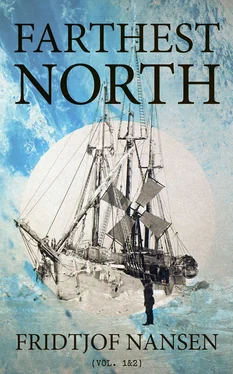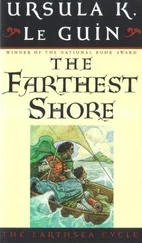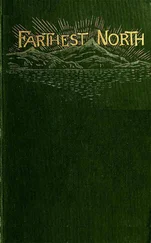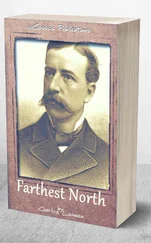As it might be of the utmost importance in several contingencies to have good sledge-dogs, I applied to my friend, Baron Edward von Toll, of St. Petersburg, and asked him whether it was possible to procure serviceable animals from Siberia. 3With great courtesy Von Toll replied that he thought he himself could arrange this for me, as he was just on the point of undertaking his second scientific expedition to Siberia and the New Siberian Islands. He proposed to send the dogs to Khabarova, on Yugor Strait. On his journey through Tiumen in January, 1893, by the help of an English merchant named Wardroper, who resided there, he engaged Alexander Ivanovitch Trontheim to undertake the purchase of thirty Ostiak dogs and their conveyance to Yugor Strait. But Von Toll was not content with this. Mr. Nikolai Kelch having offered to bear the expense, my friend procured the East Siberian dogs, which are acknowledged to be better draught dogs than those of West Siberia (Ostiak dogs), and Johan Torgersen, a Norwegian, undertook to deliver them at the mouth of the Olenek, where it was arranged that we should touch.
Von Toll, moreover, thought it would be important to establish some depots of provisions on the New Siberian Islands, in case the Fram should meet with disaster and the expedition should be obliged to return home that way. On Von Toll’s mentioning this, Kelch at once expressed himself willing to bear the cost, as he wished us in that event to meet with Siberian hospitality even on the New Siberian Islands. As it was difficult to find trustworthy agents to carry out a task involving so much responsibility, Von Toll determined to establish the depots himself, and in May, 1893, he set out on an adventurous and highly interesting journey from the mainland over the ice to the New Siberian Islands, where, besides laying down three depots for us, 4he made some very important geological researches.
Another important matter, I thought, was to have a cargo of coal sent out as far as possible on our route, so that when we broke off all connection with the rest of the world we should have on board the Fram as much coal as she could carry. I therefore joyfully accepted an offer from an Englishman, who was to accompany us with his steam-yacht to Novaya Zemlya or the Kara Sea and give us 100 tons of coal on parting company. As our departure was drawing nigh I learnt, however, that other arrangements had been made. It being now too late to take any other measures, I chartered the sloop Urania , of Brönösund, in Nordland, to bring a cargo of coals to Khabarova, on the Yugor Strait.
No sooner did the plan of my expedition become known than petitions poured in by the hundred from all quarters of the earth—from Europe, America, Australia—from persons who wished to take part in it, in spite of the many warning voices that had been raised. It was no easy thing to choose among all the brave men who applied. As a matter of course, it was absolutely essential that every man should be strong and healthy, and not one was finally accepted till he had been carefully examined by Professor Hialmar Heiberg, of Christiania.
The following is a list of the members of the expedition:
Otto Neumann Sverdrup , commander of the Fram , was born in Bindal, in Helgeland, 1855. At the age of seventeen he went to sea, passed his mate’s examination in 1878, and for some years was captain of a ship. In 1888–89 he took part in the Greenland expedition. As soon as he heard of the plan of the polar expedition he expressed his desire to accompany it, and I knew that I could not place the Fram in better hands. He is married, and has one child.
Sigurd Scott-Hansen , first lieutenant in the navy, undertook the management of the meteorological, astronomical, and magnetic observations. He was born in Christiania in 1868. After passing through the naval school at Horten, he became an officer in 1889, and first lieutenant in 1892. He is a son of Andreas Hansen, parish priest in Christiania.
Henrik Greve Blessing , doctor and botanist to the expedition, was born in Drammen in 1866, where his father was at that time a clergyman. He became a student in 1885, and graduated in medicine in the spring of 1893.
Theodore Claudius Jacobsen , mate of the Fram , was born at Tromsö in 1855, where his father was a ship’s captain, afterwards harbor-master and head pilot. At the age of fifteen he went to sea, and passed his mate’s examination four years later. He spent two years in New Zealand, and from 1886–90 he went on voyages to the Arctic Sea as skipper of a Tromsö sloop. He is married, and has one child.
Anton Amundsen , chief engineer of the Fram , was born at Horten in 1853. In 1884 he passed his technical examination, and soon afterwards his engineer’s examination. For twenty-five years he has been in the navy, where he attained the rank of chief engineer. He is married, and has six children.
Adolf Juell , steward and cook of the Fram , was born in the parish of Skåtö, near Kragerö, in 1860. His father, Claus Nielsen, was a farmer and ship-owner. In 1879 he passed his mate’s examination, and has been captain of a ship many years. He is married, and has four children.
Lars Pettersen , second engineer of the Fram , was born in 1860, at Borre, near Landskrona, in Sweden, of Norwegian parents. He is a fully qualified smith and machinist, in which capacity he has served in the Norwegian navy for several years. Is married, and has children.
Frederik Hjalmar Johansen , lieutenant in the Reserve, was born at Skien in 1867, and matriculated at the University in 1886. In 1891–92 he went to the Military School and became a supernumerary officer. He was so eager to take part in the expedition that, as no other post could be found for him, he accepted that of stoker.
Peter Leonard Henriksen , harpooner, was born in Balsfjord, near Tromsö, in 1859. From childhood he has been a sailor, and from fourteen years old has gone on voyages to the Arctic Sea as harpooner and skipper. In 1888 he was shipwrecked off Novaya Zemlya in the sloop Enigheden , from Christiansund. He is married, and has four children.
Bernhard Nordahl was born in Christiania in 1862. At the age of fourteen he entered the navy, and advanced to be a gunner. Subsequently he has done a little of everything, and, among other things, has worked as an electrical engineer. He had charge of the dynamo and electric installation on board, acted, moreover, as stoker, and for a time assisted in the meteorological observations. He is married, and has five children.
Ivar Otto Irgens Mogstad was born at Aure, in Nordmöre, in 1856. In 1877 passed his examination as first assistant, and from 1882 onward was one of the head keepers at the Gaustad Lunatic Asylum.
Bernt Bentzen , born in 1860, went to sea for several years. In 1890 he passed his mate’s examination, since which he has sailed as mate in several voyages to the Arctic Sea. We engaged him at Tromsö, just as we were starting. It was 8.30 when he came on board to speak to me, and at 10 o’clock the Fram set sail.
1.Nearly £25,000.
2.This oil, by means of a specially constructed steam-jet apparatus, was injected into the furnaces in the form of a fine spray, where it burned in a very economical and saving manner, giving forth a great amount of heat. The apparatus was one which has been applied to locomotives in England, whence it was procured. It appeared, however, that it tended to overheat the boiler at one particular point, where it made a dent, so that we soon abandoned this method of firing.
3.I had thought of procuring dogs from the Eskimo of Greenland and Hudson Bay, but there proved to be insuperable difficulties in the way of getting them conveyed from there.
Читать дальше












